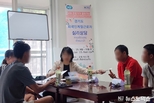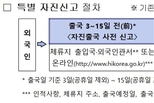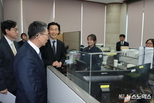
Newsnomics AJAY ANGELINA reporter |
The ‘79th Liberation Day ceremony was held for awarding Korean Nationality Certificates to Descendants of Independence Meritorious Persons by the Ministry of Justice at the Provisional Government of the Republic of Korea Memorial Hall, Seodaemun-gu, Seoul at 3 p.m. on August 12.
This event was held to repay gratitude to the great sacrifice and dedication of those who contributed in Korean independence and celebrate their descendants acquiring Korean nationality to become a full citizen of the Republic of Korea.
Minister Park Seong-jae personally awarded Korean nationality certificates to 27 descendants of independence fighters.The 27 granted for Korean nationality include 14 from Russia, 11 from China, 1 from Kazakhstan, and 1 from Cuba.
Minister Park Seong-jae, before awarding nationality certificates to Descendants of Independence Meritorious Persons said, “I hope that you, who are more special than anyone else, will become the owners and pillars of this country and further enhance the honor of your ancestors and the value of the Republic of Korea.”
Until now, a total of 1,392 descendants of independence fighters has been awarded with Korean nationality by the Ministry of Justice since 2004.
Among the ancestors of those who acquired Korean nationality this time are Choi Yi-bung and Park Young, who risked their lives in armed struggle against Japanese colonial rule, Park Jin-seong and Kim Pil-seon, who led the crowd shouting for Korean independence, and Cubans on the other side of the world. There is also a teacher, Im Cheon-taek, who took the lead in national education and military fund recruitment according to the ministry of justice.
1- Choi Yi-Bung was from Hoeryeong, North Hamgyong Province who participated in the Cheolhyeol Liberation Corps in Gando in 1919 and carried out activities to recruit members of the death squad and raise military funds.
Together with his comrades, he organized a youth group and urged Koreans working in Japanese institutions and companies to resign from their positions.
Mr.Choi was arrested at Haesamwi in 1920, but after successfully escaping, he attempted to rescue his comrades, but failed. In 1921, he organized the Red Flag Corps by integrating several independence movement groups in Noryeong Maritime Province, was elected as the leader, and carried out military actions.
Afterwards, the Red Flag Corps was renamed the Innovation Corps and the independence movement continued.
2- Mr. Park Young was born in Gyeongheung-gun, Hamgyeongbuk-do, and participated in the anti-Japanese war as an independence fighter in Manchuria and Russia.
He participated in the March 13th Independence Movement in 1919 and was active in the battles of Bongo-dong and Cheongsan-ri. Afterwards, he worked as a logistics officer for the Korean Independence Corps in Russia, purchasing weapons and recruiting cadets.
After the Jayu City Disaster, he worked in the Goryeo Revolutionary Army and returned to Yeongan-hyeon, and worked as the vice leader of the Baeksan Military Division and Shinminbu along with Cho Seong-hwan, Shin Jeong, and Kim Jwa-jin.
3- Jinseong Park was from Andong, Gyeongsangbuk-do, who planned and led the independence movement in Jungpyeong-dong, Imdong-myeon on March 21, 1919. On March 15, together with his comrades, he decided to set the 21st as the day of the rebellion and to destroy the substation if stopped by the Japanese police. On March 21, he led a protest with a crowd of about 500 people chanting for independence, and was arrested by Japanese police and sentenced to six years in prison.
4- Teacher Kim Pil-seon was from Yangyang, Gangwon-do, who planned and led the independence demonstration on Yangyang Market Day on April 4, 1919.
He distributed the Declaration of Independence and the Taegeukgi and protested with a crowd of about 4,000 people, but was later arrested and sentenced to 1 year and 6 months in prison.
5- Im Cheon-taek is from Gwangju, Gyeonggi-do, and has been active in the independence movement as a leader of the Korean community in Cuba since the 1920s.
He immigrated to Cuba in 1922 and worked as secretary, secretary, and president of the Cuban Regional Conference of the Korean National Association.
He established the Minseong Korean Language School and the Youth Academy to instill national consciousness among Korean youth, and at Kim Gu's request, military funds were provided to the Provisional Government. In addition, he was active in several independence movement organizations and worked hard to protect the rights and interests of his compatriots, educate the second generation, and foster young leaders.
Kim Ye-jeong (15), a descendant of teacher Cha Do-seon, who became a citizen of the Republic of Korea on this day, said, “I am thrilled and excited to think that I have become a true Korean,” and added, “I will follow my grandfather’s noble will and do my best to help the country as a proud citizen of the Republic of Korea.” He expressed his feelings like an adult.
In addition, Eng Lim Penzan Antonio (male, 28 years old, descendant of teacher Lim Cheon-taek) said, “My great-grandfather worked hard at Henequen Farm and sent funds to the Provisional Government,” and added, “I am grateful for my great-grandfather’s sacrifice and the support of the Korean government.” “To achieve this, I will do my best to contribute a lot to the country in the field of artificial intelligence, which I am studying,” he expressed his ambition.
The Ministry of Justice said, “We will continue to exert effort and attention to ensure that descendants of independence fighters receive appropriate treatment and support, including by continuously discovering and granting nationality to descendants of independence fighters.”










